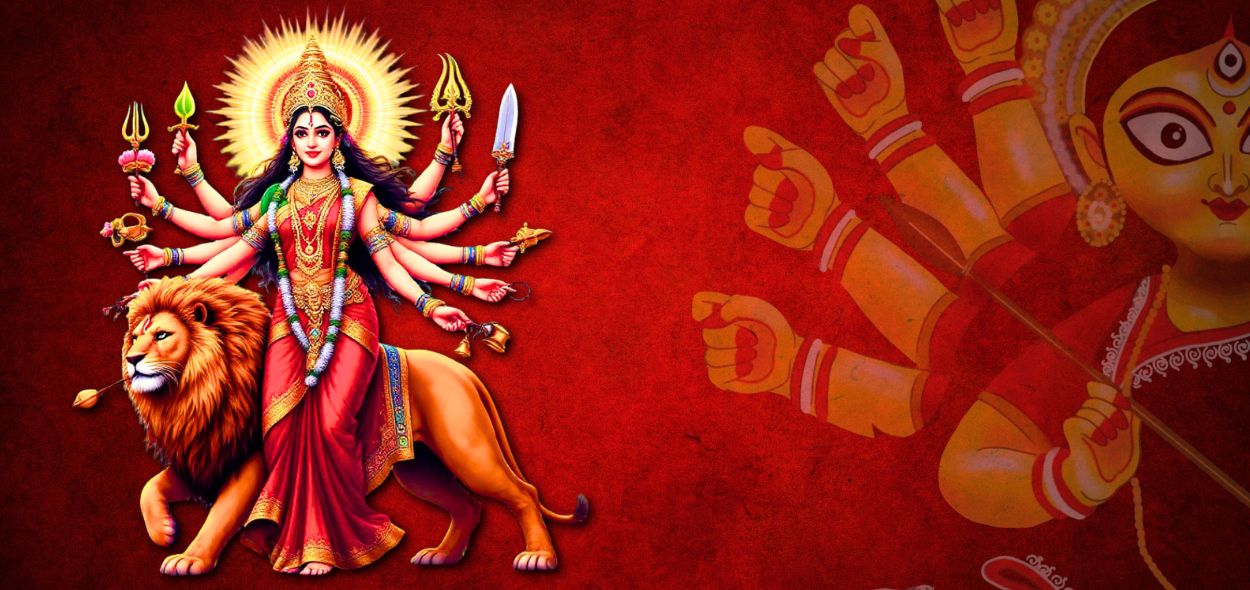
Vidushi Gaur/ New Delhi
The third day of Navratri is devoted to Goddess Chandraghanta, a form that symbolises bravery, grace, and serenity. She is the embodiment of courage tempered with compassion, teaching her devotees that true strength lies in balancing power with peace.
According to Hindu mythology, Goddess Chandraghanta is the married form of Parvati, after she weds Lord Shiva. On her forehead, she adorns a half-moon in the shape of a bell, which gives her the name Chandraghanta. Legends say that when the demon Mahishasura terrorised the heavens and earth, it was Chandraghanta who rode into battle on a lion, wielding weapons in her ten hands.
Despite her fierce warrior avatar, her face radiated calm and compassion, reassuring her devotees even amid chaos. This form of the goddess thus symbolises the victory of courage over fear and good over evil. Worshipping Chandraghanta is believed to remove obstacles, grant bravery, and bring peace of mind. Devotees pray to her for protection from negative forces, as well as for mental clarity in times of struggle.

Rituals
The third day of Navratri is marked by specific rituals that highlight the dual nature of Chandraghanta, ferocious towards evil, gentle towards devotees. Devotees often wear royal blue, symbolising tranquillity and richness. This colour is associated with spiritual depth and divine energy. Milk, kheer, or sweets made of milk are offered to the goddess, believed to bring blessings of peace and prosperity. Chanting mantras dedicated to Chandraghanta is said to awaken inner strength.
The resonating sound of bells during aarti is symbolic of driving away evil vibrations and inviting positivity. As with other Navratri days, many devotees observe a fast, consuming only fruits, milk, and light sattvic food, reinforcing discipline and purity.

In states like Uttar Pradesh, Himachal Pradesh, and Haryana, devotees worship Chandraghanta at temples decorated with flowers and bells. Large gatherings are held for kathas and recitations of the Durga Saptashati, narrating her valorous deeds. Many observe strict fasting, breaking it only after evening prayers.
In Gujarat, the third night of Navratri comes alive with Garba and Dandiya Raas, with participants dressed in blue attire to honour the goddess. The rhythmic dances around the illuminated earthen pots symbolise devotion, community bonding, and the celebration of divine energy.

In Bengal and Assam, though Durga Puja culminates later, the third day resonates with the energy of preparing for Maha Saptami. Local puja committees begin decorating pandals with elaborate artistry, and the image of Durga is often depicted with a calm yet powerful aura reminiscent of Chandraghanta.
In Tamil Nadu, Karnataka, and Andhra Pradesh, the Golu displays, tiered arrangements of dolls, gain more vibrancy by Day 3. Special pujas are held with milk-based offerings, and households invite guests for singing devotional songs. In Kerala, the day connects with Saraswati Puja traditions, with students praying for wisdom and learning.

The half-moon bell on the goddess’s forehead carries deep meaning. Bells, when rung, are believed to destroy negative energies and purify the environment. Similarly, Chandraghanta represents the removal of fear and the harmonisation of life’s dualities, anger and calm, struggle and peace. She rides a lion, signifying valour, and carries ten weapons, including a sword, trident, and mace, symbolising the power to destroy evil. Yet, her calm expression teaches that one must fight life’s battles without losing composure or compassion.
In a time marked by global uncertainty, be it personal anxieties, social upheavals, or economic challenges, the invocation of Chandraghanta inspires courage. She reminds devotees that strength lies not in aggression but in resilience and calmness amid chaos. Chandraghanta teaches that true power is not destructive but protective. For today’s leaders, parents, teachers, and individuals, this principle emphasises using authority responsibly while nurturing others.
The goddess stands as a symbol of feminine strength and fearlessness. In a society where gender equality remains an evolving struggle, her form underlines that women embody both nurturing compassion and unyielding courage.
